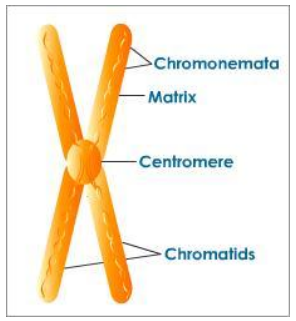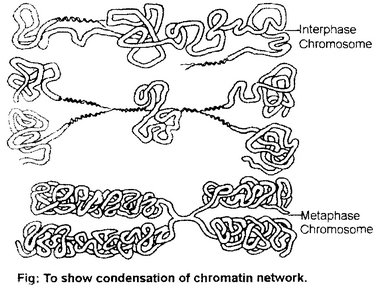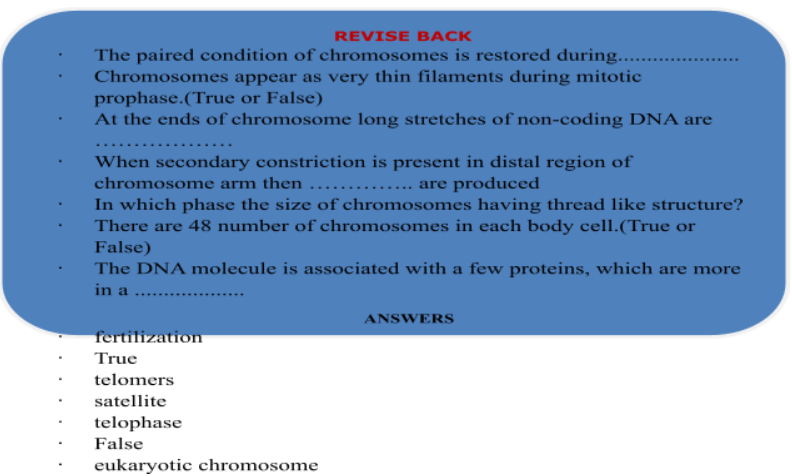
Chromosomes
Heredity And Evolution of Class 10
E.Strasburger discovered chromosomes in 1875. Achromosomeis an organized structureofDNAandproteinfound incells. It is a single piece of coiled DNA containing manygenes,regulatoryelementsand othernucleotide sequences. Chromosomes also contain DNA-bound proteins, whichserve to package the DNA and control its functions.
Chromosomal theory of Inheritance: Sutton and Boveri proposed this theory in 1902. This theory consist of following salient features:
- Somatic cellsare dipoled in number i.e., these consist of two sets of chromosomes, one set from the mother and other set from the father.
- The chromosomes retain their structural uniqueness identity and continuity
- The paired condition of chromosomes is restored during fertilization
- The behaviour of chromosomes during meiosis at the time of gamete formation provides evidence that genes are located on chromosomes. This, also explains the mechanism of segregation of characteristic at the time of gamete formation
Structure of Chromosomes :
Chromosomestructure could be explained with the help of some terminologies as given below.
- Chromatid
- Chromonema or Chromonemata
- Chromomeres
- Primary constriction or Centromere and Kinetochore
- Telomers
- Secondary Constriction
- Nucleolar Organizer
- Satellite
Chromatid:
Chromosome has two symmetrical structures at mitotic metaphase these are called aschromatidsChromatids are either sister chromatids or non-sister chromatids. Out of these sister chromatids originate from single (only one) chromosome while non-sister chromatids are derived from homologous chromosomes.
Chromonema or Chromonemata:
Chromosomes appear as very thin filaments during mitotic prophase, These are called as chromonema or chromonemata, these are chromatids in the early stage of condensation. These are present in coiled and twisted form in a chromatid during all stages ofmitosis. Genes are located on this structure. Chromatid may contain one or more chromonema.
Chromomeres:
These are serially aligned, small bead like accumulations of chromatin material that are visible along length of chromosome especially during leptotene and zygotenestages of meiosis.
These are regions of tightly foldedDNA, visible when chromosomes are relatively uncoiled. In many organisms, chromomeres situated on corresponding positions on homologous chromosomes align with each other to form homologous pairs.
Primary constriction or Centromere and Kinetochore:
Centromere is a region of DNA / chromosome (which contains highly repetitive DNA), appear mostly near the middle of a chromosome. It lies within primary constriction. Fibers of mitotic spindle attaches to this during mitosis. Kinetochore is plate or cup like structure (0.20 to 0.25nm) situated upon centromere.
Types of chromosomeare listed on the basis of number of centromeres and position of centromere.
Telomers
At the ends of chromosome long stretches of non-coding DNA are present, these are telomers.
Telomers or chromosome ends has polarity, because of this chromosome segments do not fuse with others. If chromosome breaks, the broken ends do not contain telomers, so they can stick with each other. Telomers also assist in the pairing of homologous chromosomes and crossing over.
Secondary Constriction
In addition to primary constriction there is secondary constriction. Present at any point on chromosome. The difference between these two constriction can be noticed during anaphase, as chromosome can bend only at the site of primary constriction. Secondary constrictions are constant in their position and extent, hence prove useful to identify a particular chromosome in a set. Secondary constriction may arise because the RNA genes are transcribed very actively and thus interfering with chromosomal condensation.
Nucleolar Organizer
These are some parts of secondary constrictions which contain thegenescoding for 5.8s, 18s and 28s rRNA and that induce the formation of nucleolus. Thus named as “Nucleolar Organizing Region”.
Satellite:
These are appendages of chromosome either round, elongated or knob like. Satellite is produced if secondary constriction is present in distal region of chromosome arm. It keeps connection with rest of the chromosome by a thin chromatin filament. Shape and size of satellite remains constant.
Satellite chromosome is a chromosome with satellite.

Size and Shape of Chromosomes:
Size of chromosomes greatly vary during cell cycle:
(i) Interphase: It forms long thread like structure called as chromatin.
(ii) Metaphase: Chromosomes are thickest and shortest and therefore have definite shape and size. At this stage chromosomes can be counted easily.
(iii) Anaphase: They have rod like J shaped or V shaped structures during this phase.
(iv) Telophase: They have thread like structure.

(c) Number of Chromosomes: Each species has a fixed number of chromosomes in its cells. In case of human beings, there are 46 number of chromosomes in each body cell. 46 chromosomes in an ordinary human cell are of 23 different types. So, there are two chromosomes, of each kind. The two chromosomes of each kind are called as homologous chromosomes. A cell which has the full number of chromosomes with two of each kind is called as diploid cell. In other words a diploid cell has two sets of each type of chromosomes. The gametes (or sex cells) of human being are different from their other body cells because they contain only half the number of chromosomes.
A cell which has half the number of chromosomes, with one of each kind, is called as haploid cell. In other words a haploid cell has only one set of each type of chromosomes e.g. sperm and eggs have only 23 chromosomes each, which is half the number of chromosomes of other body cells. So, the gamete is a haploid cell. Females consist of two similar gametes and therefore called as homogametic and males consist of dissimilar gametes and therefore called as heterogametic. The terms homomorphism and heteromorphy are also used for females and males respectively. During spermatogenesis two types of sperm cells will be produced one which contains X chromosome and the other which contains Y chromosome. During oogenesis each egg will produce two X chromosomes. If X-chromosome of male fuses with X-chromosome of female it will produce a female child. If Y-chromosome of male fuses with X-chromosome of female it will produce a male child.
(d) Properties of Chromosomes : The chromosomes must possess five important properties:
(i) Replication : Synthesis of new DNA molecule which is identical to the parent DNA molecule.
(ii) Transcription: Synthesis of RNA molecule from DNA molecule.
(iii) Change in appearance.
(iv) Repair: It means repair of damaged parts of DNA.
(v) Mutation : Development of genetic changes.
Functions of Chromosomes :
(i) Chromosomes are link between parents and offspring.
(ii) They contain genes and hence hereditary information.
(iii) Sex chromosomes determine sex.
(iv) Chromosomes control cell growth, cell division, cell differentiation and cell metabolism through directing synthesis of particular proteins and enzymes.
(v) Haploid and diploid chromosome number determine gametophytic and sporophytic traits.
(vi) Chance separation, crossing over and random coming together of chromosomes bring about variations.
(vii) New species develop due to change in number, form and gene complements of chromosomes.
CHROMOSOME STRUCTURE IN PROKARYOTES
In structure, a prokaryotic chromosome is much simpler in comparison to a eukaryotic chromosome.Only one chromosome is present.
A true chromosome, as found in case of eukaryotes, is not present. In a prokaryote, it is circular in shape and made up of a DNA molecule. The DNA molecule is associated with a few proteins, which are more in a eukaryotic chromosome.
Table : Differences between Chromosomes of Eukaryotes and Prokaryotes
Eukaryotic Chromosome Prokaryotic Chromosome
Many in number. Only one in number.
Possess a definite structure consisting of Structure seen in eukaryotes is not found;
chromatids and centromere. The ‘chromosome’ is circular in shape andmade up of DNA.
Proteins associated with DNA are more in A few proteins associated with DNA are
number in the chromosome. Present.





